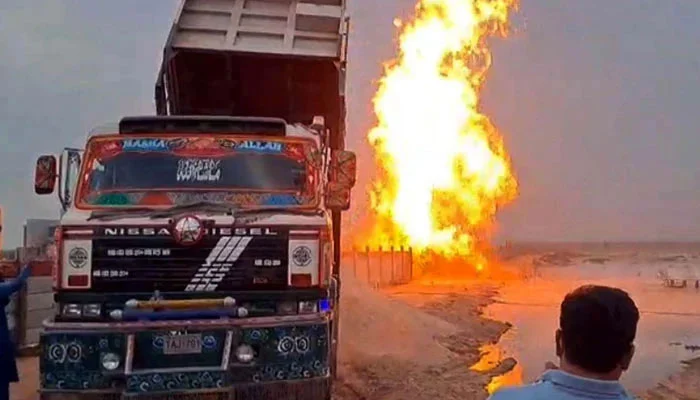The mysterious fire that erupted in the city’s Korangi area on Thursday has continued into its 13th day, with the Korangi Cantonment CEO stating that while the blaze’s spread had been contained, it was still burning with the same intensity as before.
Noting that relevant institutions had been contacted to conduct further mineral tests, the official informed that the Ministry of Petroleum had formed a committee to test for methane gas.
Speaking on precautionary measures, he mentioned that a 500-meter radius around the fire had been sealed off, and fire tenders from all six cantonments were present at the site to address any emergency.
Meanwhile, the Pakistan Atomic Energy Commission (PAEC) has also conducted a survey of the ongoing fire.
The fire, which began after a 1,200-foot-deep bore was drilled at the site on March 29, has raised concerns regarding the type and volume of gas responsible for the blaze.
A preliminary chemical analysis, according to Pakistan Petroleum Limited (PPL) sources, of the water emanating from the ditch at the Korangi fire site has revealed the presence of hazardous chemicals.
The initial report, compiled after water sampling from the fire site, detected excessive quantities of benzene, toluene, and tetrachloroethylene.
The report indicated that tetrachloroethylene was measured at 33 microgrammes per litre, significantly exceeding the standard limit of 5mg. Benzene concentrations were recorded at 19mg per litre, also surpassing the permissible threshold of 5mg.
Similarly, toluene was found at 15 microgrammes per litre, three times higher than the recommended safety level. Additionally, a slightly elevated quantity of o-xylene was also detected in the water sample, although the exact amount was not specified.
However, the preliminary findings indicated that the overall hydrocarbon content in the water was within permissible limits.
Meanwhile, sources have reported that authorities have decided to seek assistance from a globally renowned US-based firm to help extinguish the underground fire, which is suspected to have been caused by a natural gas pocket.
On another front, the technical committee formed by the Ministry of Energy has resolved to purchase two state-of-the-art gas detection meters to accurately measure the presence and concentration of natural gas in the area.
As experts evaluate the option of filling the boreholes with cement as part of the fire containment strategy, the Pakistan Refinery Limited (PRL) has been directed to immediately establish a camp office on its premises. Furthermore, all energy, petroleum, and service companies operating in Sindh have been urged to provide the necessary technical and logistical support to assist with firefighting and remedial operations.



